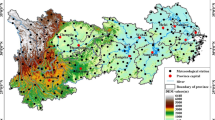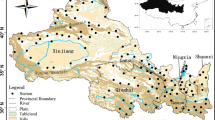Abstract
The characteristics of extreme storm events and their relationships with the El Niño Southern Oscillation (ENSO) in Korea were analyzed using rainfall. Timely rainfall series collected for over 230 years using a traditional Korean rain gauge (i.e., Chukwooki) since 1776 were employed. Even if the storm events and ENSO were difficult to compare comprehensively, return periods were identified as useful ways to explain the severity of independent storm events via a comprehensive index. Comparisons between the return periods of storm events and ENSO revealed that the annual maximum storm events in Korea were not greatly affected by ENSO. These patterns might be explained by the hypothesis that average storm events are more highly affected by domestic climate than global climate (ENSO). However, as the return period of a storm event grew, the probability of it being related to El Niño increased significantly due to combination effects of domestic and global climate factors.








Similar content being viewed by others
References
Allan R, Lindesay J, Parker D (1996) El Nino: Southern oscillation and climatic variability. CSIRO, pp 334–310
Ashok K, Yamagata T (2009) Climate change: the El Niño with a difference. Nature 461:481–484
Ashok K, Behera SK, Rao SA, Weng H, Yamagata T (2007) El Niño Modoki and its possible teleconnection. J Geophys Res: Oceans 112:C11007. doi:10.1029/2006JC003798
Brunetti M, Buffoni L, Mangianti F, Maugeri M, Nanni T (2004) Temperature, precipitation and extreme events during the last century in Italy. Glob Planet Chang 40:141–149
Choi G, Collins D, Ren G, Trewin B, Baldi M, Fukuda Y, Afzaal M, Pianmana T, Gomboluudev P, Huong PT, Lias N, Kwon WT, Boo KO, Cha YM, Zhou Y (2009) Changes in means and extreme events of temperature and precipitation in the Asia-Pacific network region, 1955–2007. Int J Climatol 29:1906–1925
Chu H, Kim T, Lee J, Lee J (2007) Seasonal relationship between El Nino-Southern Oscillation and hydrologic variables in Korea. J Korea Water Resour Assoc 40:299–311
D’Arrigo R, Cook ER, Wilson RJ, Allan R, Mann ME (2005) On the variability of ENSO over the past six centuries. Geophys Res Lett 32:L03711. doi:10.1029/2004GL022055
Diaz HF, Markgraf V (2000) El Niño and the Southern Oscillation: multiscale variability and global and regional impacts. Cambridge University Press, Cambridge
Elsey L (2004) ENSO defined Weatherwise January/February 2004 11–12
Evans MN, Kaplan A, Cane MA (2002) Pacific sea surface temperature field reconstruction from coral δ18O data using reduced space objective analysis. Paleoceanography 17:7-1–7-13. doi:10.1029/2000PA000590
Fréchet M (1951) Sur les tableaux de correlation dont les marges sont donnees. Ann Univ Lyon Sci Sect A 14:53–77
Freund JE (1961) A bivariate extension of the exponential distribution. J Am Stat Assoc 56:971–977. doi:10.1080/01621459.1961.10482138
Gergis JL (2006) Evidence from tree-ring, coral, ice and documentary palaeoarchives, AD 1525–2002. University of New South Wales, Sydney
Gergis JL, Fowler AM (2005) Classification of synchronous oceanic and atmospheric El Niño-Southern Oscillation (ENSO) events for palaeoclimate reconstruction. Int J Climatol 25:1541–1565. doi:10.1002/joc.1202
Gumbel EJ (1960) Bivariate exponential distributions. J Am Stat Assoc 55:698–707. doi:10.1080/01621459.1960.10483368
Gumbel EJ (1965) Two systems of bivariate extremal distributions, 35th session of the International Statistical Institutem Beograd, pp 69
Hanley DE, Bourassa MA, O’Brien JJ, Smith SR, Spade ER (2003) A quantitative evaluation of ENSO indices. J Clim 16:1249–1258. doi:10.1175/1520-0442(2003)16<1249:AQEOEI>2.0.CO;2
Jung H-S (1999) Interpretation of the transient variations in the time series of precipitation amounts in Seoul. Doctoral Dissertation, Seoul National University
Jung H-S, Lim G-H (1994) On the monthly precipitation amounts and number of precipitation days in Seoul, 1770–1907. Asia-Pac J Atmos Sci 30(4):487–505
Jung H-S, Lim G-H, Oh J-H (2001) Interpretation of the transient variations in the time series of precipitation amounts in Seoul, Korea: part I. Diurnal variation. J Clim 14:2989–3004. doi:10.1175/1520-0442(2001)014<2989:IOTTVI>2.0.CO;2
Kawamura R (1998) A possible mechanism of the Asian summer monsoon-ENSO coupling. J Meteorol Soc Jpn 76(6):1009–1027
Kim H, Ahn J, Yoon Y, Park M (1999) Investigation of nonlinearities for El Niño/Southern Oscillation index. J Korean Soc Civ Eng 19:149–157
Kim KY, Roh JW, Lee DK, Jhun JG (2010) Physical mechanisms of the seasonal, subseasonal, and high-frequency variability in the seasonal cycle of summer precipitation in Korea. J Geophys Res 115:D14110. doi:10.1029/2009JD013561
Korea Institute of Construction Technology (2002) 2002 Flood in Gangwondo region by Typhoon Rusa. Korea Institute of Construction Technology, Goyang
Kotz S, Balakrishnan N, Johnson NL (2000) Continuous multivariate distributions. Volume 1: models and applications. Wiley, New York, pp 350–362
Lee D (1998) Relationships of El Ni o and La Ni a with both temperature and precipitation in South Korea. J Korea Water Resour Assoc 31:807–819
Lim G-H, Jung H-S (1992) Interannual variation of the annual precipitations at Seoul, 1771–1990. J. Korean Meteorol Soc 28:487–505
Mann ME, Bradley RS, Hughes MK (1998) Global-scale temperature patterns and climate forcing over the past six centuries. Nature 392:779–787
McPhaden MJ (2004) Evolution of the 2002/03 El Niño. Bull Am Meteorol Soc 85:677–695. doi:10.1175/BAMS-85-5-677
Ministry of Construction and Transportation (2006) Investigation report on the damages by the Typhoon and intensive rainfall on July 2006. GOVP1200713914, Ministry of Land, Transport and Maritime Affairs, Seoul, Korea
National Emergency Management Agency (2009) Research on flood mitigation from inland inundation. National Emergency Management Agency, Seoul
National Institute for Disaster Prevention (2002) The field survey report of damages caused by the Typhoon RUSA in 2002. National Institute for Disaster Prevention, Seoul
Piccarreta M, Pasini A, Capolongo D, Lazzari M (2013) Changes in daily precipitation extremes in the Mediterranean from 1951 to 2010: the Basilicata region, southern Italy. Int J Climatol 33:3229–3248
Piccarreta M, Lazzari M, Pasini A (2014) Trends in daily temperature extremes over the Basilicata region (southern Italy) from 1951 to 2010 in a Mediterranean climatic context. Int J Climatol. doi:10.1002/joc.4101
Rasmusson EM, Carpenter TH (1983) The relationship between eastern equatorial Pacific sea surface temperatures and rainfall over India and Sri Lanka. Mon Weather Rev 111:517–528. doi:10.1175/1520-0493(1983)111<0517:TRBEEP>2.0.CO;2
Ronghui H, Yifang W (1989) The influence of ENSO on the summer climate change in China and its mechanism. Adv Atmos Sci 8(1):21–32
Ronghui H, Wen C, Bangliang Y, Renhe Z (2004) Recent advances in studies of the interaction between the East Asian winter and summer monsoons and ENSO cycle. Adv Atmos Sci 21(3):407–424
Ropelewski CF, Halpert MS (1989) Precipitation patterns associated with the high index phase of the Southern Oscillation. J Clim 2:268–284. doi:10.1175/1520-0442(1989)002<0268:PPAWTH>2.0.CO;2
Stahle DW et al (1998) Experimental dendroclimatic reconstruction of the Southern Oscillation. Bull Am Meteorol Soc 79:2137–2152. doi:10.1175/1520-0477(1998)079<2137:EDROTS>2.0.CO;2
Trenberth KE (1997) The definition of El Nino. Bull Am Meteorol Soc 78:2771–2777
Wang B, Chan JCL (2002) How strong ENSO events affect tropical storm activity over the western North Pacific. J Clim 15:1643–1658
Wang S-W, Zhao Z-C (1981) Droughts and floods in China, 1470–1979. In: Wigley TML, Ingram MJ, Farmer G (eds) Climate and history: studies in past climates and their impact on man. University Press, Cambridge, pp 271–288
Yoo C (2006) Long-term analysis of wet and dry years in Seoul, Korea. J Hydrol 318(1–4):24–36
Author information
Authors and Affiliations
Corresponding author
Rights and permissions
About this article
Cite this article
Park, M., Choi, M. The relationships between El Niño Southern Oscillation and extreme storm events in Korea. Environ Earth Sci 74, 351–362 (2015). https://doi.org/10.1007/s12665-015-4040-4
Received:
Accepted:
Published:
Issue Date:
DOI: https://doi.org/10.1007/s12665-015-4040-4




